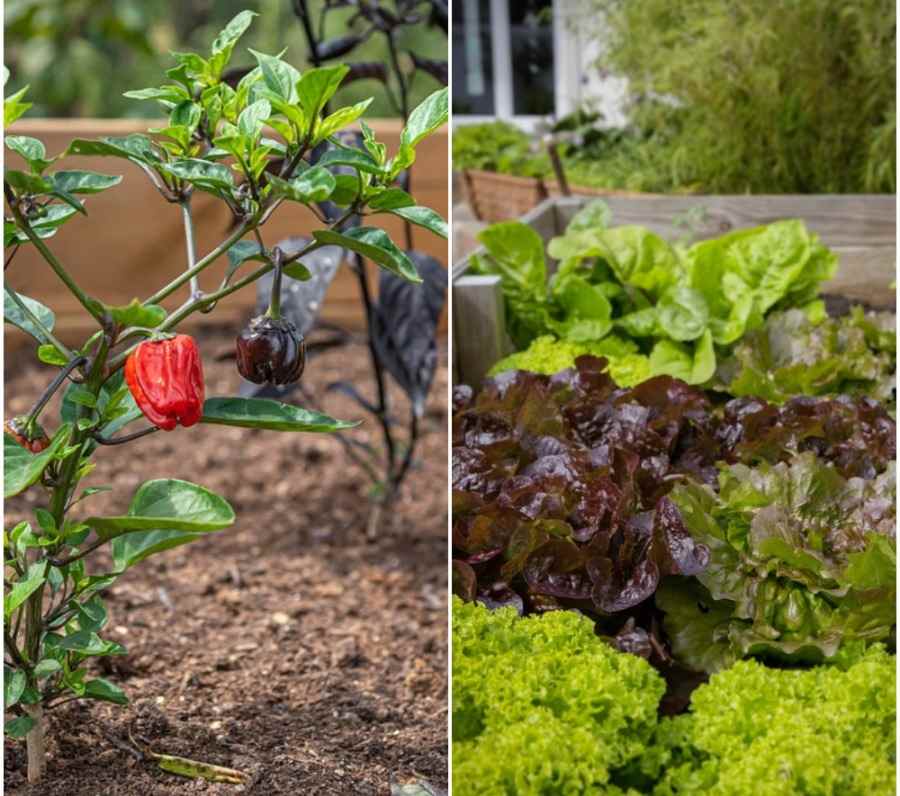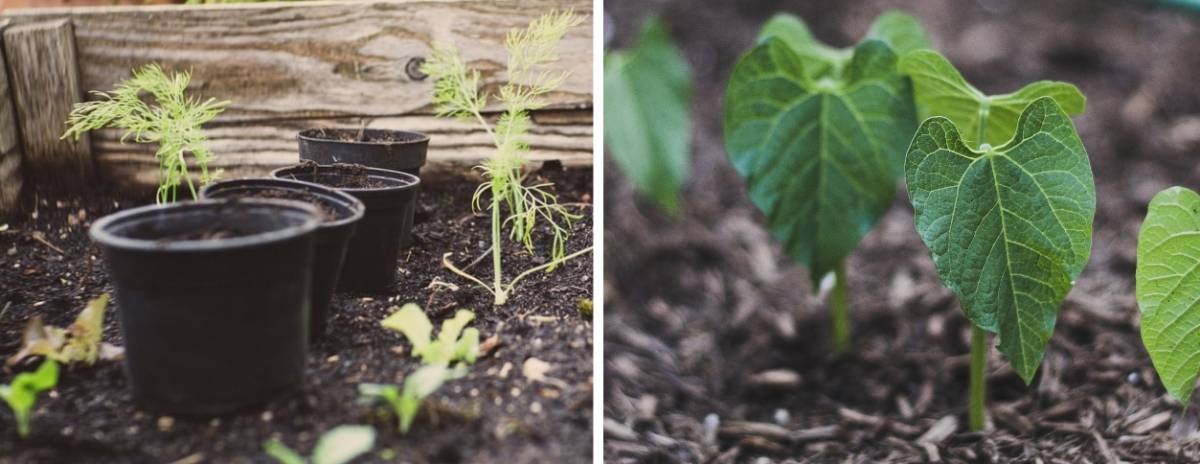Introduction to vegetable spacing in the raised bed garden
Raised bed garden is classified as condensed gardening, as most vegetables can be planted more closely together, so maximizing available space and productivity. Different types of vegetables need different amounts of free space to ensure healthy growth and a good crop. Many gardeners plant closer together than suggested when using raised beds. This is based on the idea that the raised beds have a better quality of soil and therefore the plants will grow better in a smaller space. Now, there is some truth in this and you could get away with planting most things leaving half the amount of space as you normally would, but we would always recommend that you stick to the planting information unless you are an experienced gardener. Our reason for this is that it takes a fairly experienced gardener to know the quality of the soil and to know how the different types of vegetables grow. Raised bed gardens are an excellent option when it comes to vegetable gardening since they provide a simple but effective alternative to growing in poor soil. A raised garden bed is a planting area that sits above the ground. One of the benefits of a raised bed garden is you can reach into them to plant and weed. You are not walking through the garden, compacting the soil. This means your garden soil remains nice, loose, and friable. In this article we also discuss below topics;
- What vegetables grow best in a raised garden bed
- How deep should a raised bed garden
- Is it better to grow vegetables in a raised bed garden?
- How far apart do you plant tomatoes in a raised bed
- Should you like a raised garden bed
- Can you plant vegetables closer together in a raised bed?
- How do you space vegetables in a raised bed
- Do vegetables grow better in raised beds
- The different vegetable spacing requirement for raised bed gardening
A step by step guide to vegetable spacing in the raised bed garden
In a raised bed garden, plants are grown more closely together than in a traditional row garden. Most vegetables don’t appreciate having wet feet, so well-drained soil is important. If your existing soil is less than ideal, a raised bed can be your best option. Raised beds offer many advantages. They warm up early in the spring season, drain well, and can be intensively planted which means more food in less space. You can line your raised bed to make it durable and to prevent toxins from leaching into the soil. For lining, use landscape fabric found at garden supply stores and cloth fabric from clothing. And, avoid non-porous plastic, as it can retain too much water and discourage beneficial insects and worms.
A raised bed is simply when the level of the soil is higher than the surrounding ground. The several benefits of gardening in a raised bed. A few of these benefits are;
- Higher yields
- Improved soil conditions
- Ease of working
- Ease of pest control
- Water conservation
Why should you build a raised bed garden?
Raised beds have many benefits, here are some reasons why you should consider;
- Garden chores are made easier and more comfortable with less bending and kneeling. Save your back and knees from the strain and pain of tending the garden. The productivity of plants is improved due to deeper rooting and better drainage.
- Raised beds are ideal for small spaces where a conventional row garden may be too wild and unwieldy. Raised beds help to maintain things organized and in check.
- Raised bed planting provides full control over soil quality, which is particularly important in areas where the existing soil is rocky, nutrient-poor, and riddled with weeds.
- Raised bed gardens allow for a longer growing season since you can work the soil more quickly in the spring in frost-hardened regions, or change the bed into a cold frame in the fall.
- Fewer weeds are seen in raised beds thanks to the bed being raised away from surrounding weeds and being filled with disease and weed-free soil.
How much deep should soil be in a raised bed garden?
The perfect depth of soil in a raised bed garden should be between 8 and 12 inches with more being preferred. That way, your plants can still grow even if you place it on concrete. Though, you should have taller garden beds or place them on top of the earth if you would like to plant anything that requires more than 8 inches of soil.
A well-prepared raised bed allows the soil to drain more than in an in-ground garden. In some areas of, the soil drains so poorly that raised beds enable gardening of crops that would not otherwise grow.
Location and set-up of raised bed garden
For optimum plant health and productivity, most vegetables should receive at least 8 hours of full sun each day. The more sun, the better, so it makes sense to locate your garden in the sunniest part of your yard. Avoid low, wet areas where the soil could stay soggy. Because your garden will need to be watered during the growing season, you’ll want to have relatively easy access to a hose.
In case if you miss this: Making Compost from Dry Leaves and Flowers.

Good soil is one of the most important ingredients for a good garden. Raised beds give you an instant advantage over a regular garden because when you fill your raised bed, you can fill it with a blend of soil that’s superior to the native soil in your yard. Soil having loose and rich with nutrients and organic matter will allow the roots of your plants to grow freely, and confirm that they have access to the water and nutrients they need to sustain healthy growth.
Choosing a raised bed
Gardener’s Supply offers a wide range of raised beds, from aluminum corner kits for which you supply your lumber, to complete raised bed kits in cedar, composite wood, galvanized steel, and recycled plastic. You can consider elevated raised beds, for no-bend gardening.
Raised beds range in height, starting at about 6 inches. On the whole, the more soil depth that’s available to your plants, the more freely their roots will grow. More soil also holds more moisture, so a deeper raised bed will need less frequent watering.
It is possible to install a raised bed on poor or compacted soil, or even on concrete. If this is the situation you have, buy the deepest bed you can afford. A depth of 10 to 12 inches is preferable. Keep in mind that the deeper the bed, the more soil you’ll need to fill it. Use the Soil Calculator to determine how much soil you’ll need.
How many raised beds should you have? If your space or time is limited, you might want to start with just one. If you’re trying to produce lots of your fresh vegetables, you will probably need at least three or four beds. Use the Kitchen Garden Planner, our free online garden design tool, to select and place the crops you want to have in each bed. This will help you determine how many total beds you’ll need to accommodate everything you want to grow.
Vegetable spacing requirements in the raised bed garden
Using the block-style layout for a raised vegetable bed, the most common vegetables are planted in a grid pattern across the bed. Plant space measurements are suggested but can be corrected once you determine if plants can be grown even more closely together or as the soil quality improves.
You should not miss this: Epsom Salt For Gardening, Uses, Application, Benefits.

List of vegetable spacing in the raised bed garden is;
Asparagus – Spacing for asparagus plants is 12 to 18 inches apart so you’ll need a large raised bed to accommodate several of the plants.
Basil – Basil works great in raised beds, as these allow for better drainage. Space basil plants about 12 to 18 inches apart.
Beans – Space beans plants about 3 to 4 inches apart.
Brussels sprouts -For best results, Brussels sprouts need at least 15 to 18 inches of space per plant. If you want to include them in your raised bed, plan your garden so some space around your Brussels sprouts will open up as the season progresses.
Cabbage – Space cabbage plants about 15 to 18 inches apart.
Carrots – A raised bed garden provides carrots with the perfect soil conditions to reach their full potential. With deep, loose soil and consistent moisture, they’ll develop long, straight plant roots with beautiful colors and satisfying crunch.Space Carrot plants about 2 to 3 inches apart.
Cauliflower – Space Cauliflower plants about 12 to 15 inches apart,
Chinese cabbage – Space Chinese cabbage plants about 6 to 9 inches apart.
Collards – Space collards plants about 10 to 12 inches apart.
Corn – Corn grows well in raised beds if you plant enough to ensure proper pollination and space corn plants about 8 to 10 inches apart.
Cucumbers – Space Cucumber plants about 12 to 18 inches apart.
Dill – Space dill plants about 10 to 12 inches apart.
Eggplant – Eggplant spacing in a raised bed is 12 to 18 inches apart.
Endive – Endive spacing in a raised bed is 8 to 12 inches apart.
Garlic – Garlic spacing in a raised bed is 3 inches apart.
Kale – Space kale plants about 6 to 8 inches apart.
Kohlrabi – Space Kohlrabi plants about 3 to 6 inches apart.
Leeks – Space Leeks about 2 to 3 inches apart.
Mustard – Space Mustard plants about 3 to 4 inches apart.
Okra – Grow okra in a raised bed where you can provide optimal soil and also growing conditions. Space okra plants about 10 to 12 inches apart.
Onions – Space onionsabout 3 to 4 inches apart.
Parsley– Space parsleyplants about 4 to 6 inches apart.
Parsnips – Space Parsnips about 3 to 4 inches apart.
Peas – Sow peas in raised beds in spring or where the soil is heavy or drains poorly. Space peasabout 1 to 2 inches apart.
Peppers – Space pepperplants about 12 to 15 inches apart.
Potatoes – Loosen the soil in the bottom of a half-filled raised bed and space seed potatoes about 12 inches apart in all directions and bury them 3 inches deep.
Pumpkins – In a raised bed garden, plant pumpkins near the edge of the bed so you can train the vine over the edge, leaving the rest of the bed for other plants. Pumpkin spacing in a raised bed is 24 to 36 inches apart.
Radishes – Radish spacing in a raised bed is 2 to 3 inches apart.
Sage – Sage spacing in a raised bed is 12 to 18 inches apart.
Spinach- When growing spinach in a raised garden bed (soil loosened 20-24 inches deep), plant spinach on 8 inches (20 cm) centers (seeds or seedlings 8 inches (20 cm) apart in every direction).
Squash– Squash spacing in a raised bed is 18 to 24 inches apart.
Sweet potatoes -Sweet potatoes spacing in a raised bed is 10 to 12 inches apart.
Swiss chard -Swiss chard spacing in a raised bed is 6 to 9 inches apart.
Tomatoes – Tomatoes can be deeply planted since roots can form along the length of the stems and plant them at 18 to 24-inches spacing.
In case if you are interested in this: Male and Female Flowers in Plants.